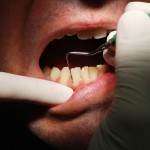
Periodontitis is a very common disease and a leading cause of tooth loss. Early identification of patients at risk together with early treatment is important and a number of risk assessment tool have been developed. However, most are considered to be qualitative assessments as they lack accurate probability calculations needed for prediction studies. While a number of models have been developed aiming to predict, prevalence, incidence, progression and tooth loss there are concerns about their performance.
The aim of this review was to current prediction models for periodontitis incidence and progression.
Methods
Searches were conducted in the PubMed/Medline, EMBASE, DOSS, Scope, Web of Science and ProQuest databases. Studies describing the development, validation or assessment of a model that was constructed to predict the incidence or progression of periodontitis used in the general population were considered. Two reviewers independently selected studies and extracted data using the CHARMS checklist . The CHARMS checklist and Newcastle-Ottawa Scale were used to assess risk of bias. Because of study heterogeneity a narrative summary was undertaken.
Results
- 7 studies were included.
- 3 reported on risk assessment models, 3 on prediction models and 1 on both.
- 12 prediction models were reported with 4 models from 1 study examining incidence with others assessing prevalence.
- Common predictors used in modelling were, age, smoking and diabetes.
- Only 2 studies reported external validation
- The model’s predictive performance could not be assessed or compared
- The models were considered to have a ‘good’ ability to discriminate between patients at risk of periodontitis.
Conclusions
The authors concluded: –
This is the first systematic review of prediction modelling studies for periodontitis incidence and progression. It revealed several methodological and reporting shortcomings of published prediction models and indicated further research is required. Logistic regression, generalised linear mixed regression and latent class analysis were used as predictive modelling approaches. Existing models covered the most likely predictors for periodontitis development in adults and achieved acceptable predictive accuracy, but the absence of consensus regarding periodontitis measurement and classification complicates modelling. In the future predictive modelling studies, it is essential to conduct cross-validation and/or out-of-sample estimation and/or validation with a second data set, both for variable selection and for measures of prediction accuracy, in order to avoid overfitting. More efforts can be made in taking into account new predictors, such as microbiological information, biological markers and machine-learning approaches, such as decision tree, or neural network.
Comments
There is growing interest in the area of prediction and the recently released new classification of periodontal and peri-implant diseases and conditions is based on a multidimensional staging and grading system which reflects severity, risk of aggressiveness and progression may help in the future.
As the review have pointed out the currently available literature has a number of methodological and reporting shortcoming so further research is needed. They also highlight the new TRIPOD statement which will outlines reporting guidelines for reporting of prediction models for individual prognosis or diagnosis pointing out that nearly half of the items considered essential were either not reported or inadequately reported in the studies identified for this review.
Links
Primary Paper
Du M, Bo T, Kapellas K, Peres MA. Prediction models for the incidence and progression of periodontitis: A systematic review. J Clin Periodontol. 2018 Nov 5. doi: 10.1111/jcpe.13037. [Epub ahead of print] Review. PubMed PMID: 30394558
Original review protocol on PROSPERO
Other references
Tonetti MS, Greenwell H, Kornman KS. Staging and grading of periodontitis: Framework and proposal of a new classification and case definition. J Periodontol. 2018 Jun;89 Suppl 1:S159-S172. doi: 10.1002/JPER.18-0006. Erratum in: J Periodontol. 2018 Dec;89(12):1475. PubMed PMID: 29926952.

[…] Periodontitis: How good are current prediction models? […]